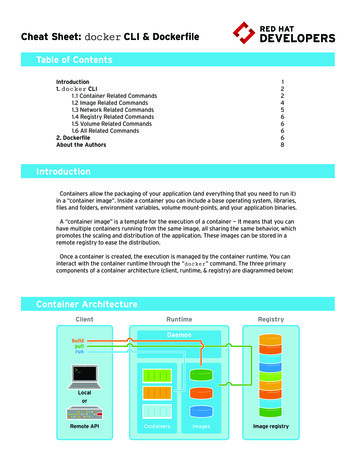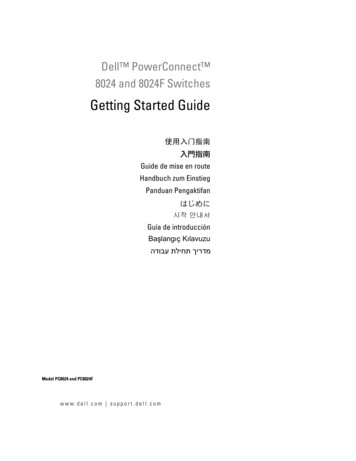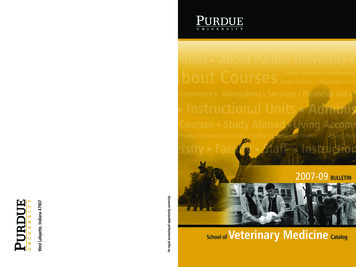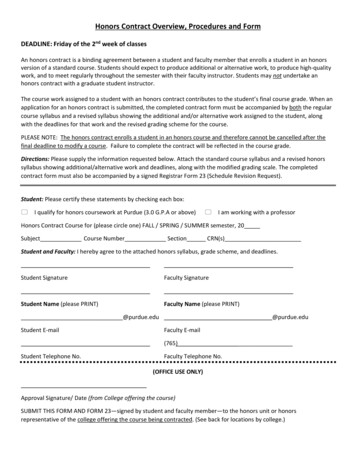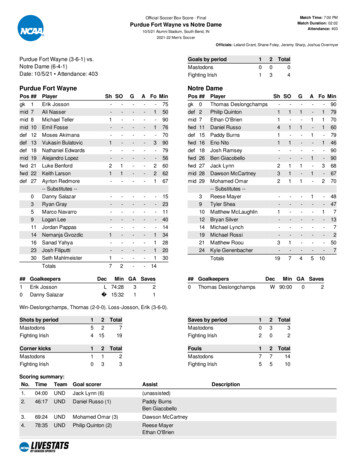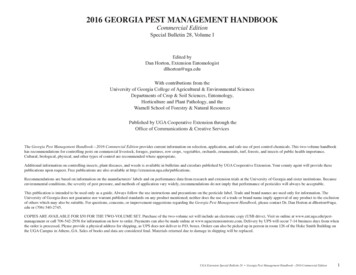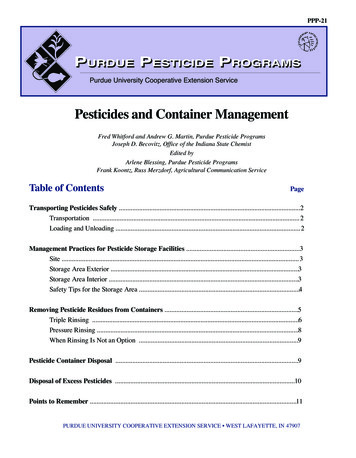
Transcription
PPP-21PURDUEURDUE PESTICIDEESTICIDE PROGRAMSROGRAMSPurdue University Cooperative Extension ServicePesticides and Container ManagementFred Whitford and Andrew G. Martin, Purdue Pesticide ProgramsJoseph D. Becovitz, Office of the Indiana State ChemistEdited byArlene Blessing, Purdue Pesticide ProgramsFrank Koontz, Russ Merzdorf, Agricultural Communication ServiceTable of ContentsPageTransporting Pesticides Safely .2Transportation . 2Loading and Unloading . 2Management Practices for Pesticide Storage Facilities .3Site . 3Storage Area Exterior .3Storage Area Interior .3Safety Tips for the Storage Area .4Removing Pesticide Residues from Containers .5Triple Rinsing .6Pressure Rinsing .8When Rinsing Is Not an Option .9Pesticide Container Disposal .9Disposal of Excess Pesticides .10Points to Remember .11PURDUE UNIVERSITY COOPERATIVE EXTENSION SERVICE WEST LAFAYETTE, IN 479071
Proper management of pesticide containers generally is a straightforward procedure, but it requires careful thoughtand a proper attitude. Appropriate transportation and storage of pesticides help protect the environment, assure workersafety, save money, and avoid legal problems.Transporting Pesticides SafelyOnce you purchase a pesticide, you are responsible for its safe transportation. Accidents can occur when transporting pesticides even a short distance. Careless transportation can result in broken containers and spills that mightcontaminate the environment or cause personal injury. Know how to prevent transportation problems, and be prepared foran emergency.Transportation Vehicles must be in safe operating condition. The back of an open pickup truck is the best mode. Vans, minivans, and station wagons, although less than ideal,may be used if the windows are left open to prevent vapor accumulation. Pesticides should not be transported in compact or mid-size automobiles except as a last resort. If a car must beused, place the containers in the trunk and make certain that both the trunk and passenger space are well ventilated;i.e., leave the trunk lid ajar and open the windows. Travel at a reduced speed and, when necessary, use slowmoving-vehicle emblems. Never- transport pesticides in the passenger space of aclosed vehicle;- allow passengers or pets to ride with the pesticides;- leave an unsecured vehicle unattended if it containspesticides.Loading and Unloading Inspect each container before loading, and confirm that- labels are attached and legible;Always transport pesticides in an open or wellventilated vehicle. (Photo courtesy of IllinoisCooperative Extension Service)- all caps are tightly closed and properly sealed;- the outside is not contaminated with pesticide;- a current Material Safety Data Sheet (MSDS) accompanies each pesticide. Always transport pesticides in their original, labeled containers. Avoid carrying glass containers; if there is no alternative, wrap them in foam packing materials to prevent breakage. Protect pesticide bags from punctures, tears, and moisture during transport. Secure all pesticide containers to prevent rolling and sliding. Avoid transporting fertilizer, seed, feed, drugs, clothing, and foodstuffs with pesticides. Transfer pesticide containers to an appropriate storage facility immediately upon reaching your destination.2
Management Practices for Pesticide Storage FacilitiesSafety is the key element in storing pesticides. Proper storage will protect the environment and the people wholive and work near the storage area. Proper storage of pesticides prolongs chemical shelf life; reduces risk to people and livestock; eliminates surface contamination; prevents ground water contamination.It is best to build and/or designate a separate building specifically for storage of large quantities of pesticides. Ifa separate facility is not possible, a precise area within an existing building should be specified for pesticide storage. Thefollowing guidelines will help ensure safe and environmentally friendlystorage of pesticide products.Site Pesticide storage facilities- must be located away from human and livestock habitat;- must not be constructed in areas that are known to flood;- should be built as separate structures dedicated for pesticide storage;- should be situated so that runoff from spills and leakscannot contaminate surface water, drains, wells, etc.;- should be at least 100 feet from sensitive areas such aswellheads.Ideally, pesticides should be stored in aseparate building. Commercial dealers and applicators should consider these conditions when siting a storage facility:- prevailing wind- proximity of surrounding commercial and residential areas- potential fire hazard- availability of emergency response servicesStorage Area ExteriorAlways post and lock pesticide storage areas. Secure the storage facility (separate building, room, cabinet)against theft, vandalism, and unauthorized access. Post the storage area with warning signs labeled “DANGER - PESTICIDES - KEEP OUT” on walls, doors, andwindows. Signs should be legible at least 50 feet from the building. Store drums on sides to avoid accumulation of rainwater in top or bottom recessed areas.Storage Area Interior Pesticides should always be stored on the ground floor. Buildings used for pesticide storage should not containoffice space unless pesticides can be completely isolated and good ventilation can be maintained.3
The interior of the storage area- should be well-lighted and dry;- should have a cement floor to facilitate cleanupof spills (maintain floor to prevent cracking);- should not contain floor drains or sump pumps(floor drains, if present, should be completelysealed);- should be equipped with exhaust fans to preventvapor accumulation and heat buildup (vent fansso that no people, animals, or plants are exposedto the fumes);Emergency Preparedness and CommunityRight-to-knowTitle III of the Superfund Amendments and Reauthorization Act (SARA), also called the EmergencyPlanning and Community Right-To-Know Act of1986, requires that the storage of certain specifiedextremely hazardous substances be reported to localemergency planning commissions. While SARA,Title III, primarily affects pesticide manufacturersand commercial dealers, individuals storing largequantities of certain pesticides may also have tocomply with the law. For further information,consult Pesticides and Community Right-to-Know,PPP-32.- should be insulated to help maintain an evenroom temperature (pesticides should never freezeor become excessively hot; specific temperature information generally is provided on the pesticide label;the range normally recommended for liquid pesticides is 40-100 F);- should contain metal shelves with lips for storing chemicals off the floor (wooden shelves are unacceptablebecause they can absorb spilled pesticides; large metal drums and nonmetallic containers should be kept onpallets);- should include an area for storing properly rinsed, empty containers awaiting disposal. Store liquid pesticides and highly toxic pesticides (those with “DANGER” on the label) on low shelves to minimizethe potential for exposure if the containers are broken or begin to leak. Containers should not extend beyond theshelving. Separate pesticides by classification (herbicides, insecticides, fungicides, etc.) within the storage facility to preventcross-contamination and decrease the likelihood of accidental misuse. Never keep seed, fertilizer, feed, drinking water, veterinary supplies, protective equipment, or foodstuffs in apesticide storage area.Safety Tips for the Storage Area Always store pesticides in their original containers with the original label attached. However, if a pesticide container is leaking, transfer the chemical to a sturdy new container that can be sealed. Attach the original label to thenew container, or label the new container with specific information immediately. Purchase only the quantities of pesticides required for a single season to minimize the need for off-season storage. Keep the storage site neat and tidy. Pesticide handlers must be able to- see pesticide labels;- detect leakage or corrosion;- get to leaks or spills to clean them up. Store protective equipment and clothing in a nearby location that provides immediate access but is away frompesticides and their fumes, dusts, or possible spills. Provide an immediate supply of clean water, and have an eyewash dispenser immediately available for emergencies. Soap and a first aid kit are also necessary. Establish procedures to control, contain, and clean up spills. Familiarize everyone with the procedures.4
Provide tools (shovel, broom, dustpan) and absorbent materials (clay, sawdust, shredded paper) to clean up spills. Mark pesticide containers with the date of purchase and rotate inventory to ensure that the oldest material is usedfirst. Keep- an accurate, up-to-date stored pesticide inventory;- a file of product labels available for reference;- a file of Material Safety Data Sheets;- a building floor plan showing the exact location of pesticides;- emergency phone numbers (police, fire, poison control center, Indiana Department of EnvironmentalManagement Emergency Response) at the storage area and in the office. Maintain an inventory of all safety kits and signs.EDUCATION INFORMATIONPurdue University Cooperative Extension ServicePurdue Pesticide Programs, (765) 494-4566Local Extension Agent, (888) 398-4636 Develop a fire emergency plan in consultation withthe local emergency planning committee and fire,police, and sheriff’s departments. Notify theappropriate officials of the types of pesticides andquantities stored.REGULATORY INFORMATIONState Regulatory Information, andInformation on Pesticide Applicator Certification& LicensingOffice of the Indiana State Chemist, (765) 494-1594Federal Regulatory InformationU.S. Environmental Protection Agency, Region V,(312) 353-2000 Know and follow local fire codes. Consult withlocal fire authorities regarding the best methods forfire protection: water, foam, dry chemical, halon, orcarbon dioxide.Removing Pesticide Residues fromContainersEMERGENCY INFORMATIONHot Line: Chemtrec, (800) 424-9300Accidental poisoning: Indiana Poison Center,(800) 858-7378Spills: Indiana Department of EnvironmentalManagement, (888) 233-7745Product labels direct applicators to triple rinseeach empty pesticide container, pour the rinse solution(rinsate) into the spray tank mixture, and use the productaccording to the label. Triple rinsing—washing out eachpesticide container three times—is a procedure that hasweathered the storms of regulatory change for nearly 20years. This method reduces the potential for environmental damage by converting pesticide containers from hazardouswaste to solid waste. Also, triple rinsing ensures that all of the pesticide product is incorporated into the tank mixture sothat applicators get their money’s worth.At a time when pesticide applicators are overwhelmed by scientific information, the benefits from simple techniques such as rinsing pesticide containers often are overlooked. Examine the consequences of improper management ofpesticide containers: Drinking water can be contaminated if improperly rinsed containers are deposited in landfills. Local, state, and federal laws may be violated, causing legal problems for the applicator. Expensive material can be left in each unrinsed container.Triple rinsing is defined by a 1974 federal regulation as the “flushing of containers three times, each time using avolume of the normal diluent equal to approximately ten percent of the container’s capacity, and adding the rinse liquidto the spray mixture.” Pesticide labels on metal, plastic, and glass containers reflect this federal definition when directingapplicators to triple rinse or the equivalent. The following instructions explain two commonly accepted residue removaltechniques: triple rinsing and pressure rinsing.5
Triple Rinsing1. The same personal protective equipment worn while handling the pesticide concentrate during the mixingprocess should be worn while rinsing containers.2. The procedure for rinsing containers should begin immediately after emptying the contents into the application equipment. Allowing the residue to dry in the empty containers for even a few hours will reduce theeffectiveness of the procedure. If you can’t rinse them immediately, leave the caps on the containers untilyou are prepared to do so. This will help prevent the pesticide from drying inside the containers.3. Pour the pesticide into your spray solution and let the container drain for an additional 30-60 seconds. Thisstep greatly enhances your ability to remove the residue during the triple rinsing process.4. Add clean water (or other diluent specified on the label) equal to 10-25 percent of the container’s volumeand secure the cap.5. Shake or roll the container so that the interior surfaces will be rinsed.6. Pour the rinsate into the spray mix and allow the container to drain for an additional 30 seconds. Thiscompletes the first cycle.7. Repeat the procedures outlined in steps 4-6. This completes the second cycle.8. Again, repeat steps 4-6. If the rinsate still appears cloudy or milky, keep repeating until the water looksclear, indicating a thorough rinse. If the pesticide is an emulsifiable concentrate (EC) or a liquid flowable(LF), multiple rinses are always advisable.9. Render all plastic and metal containers unusable by puncturing or crushing.10. The final step is to dispose of the containers in a sanitary landfill or offer them for recycling.Repeat the rinsing process until the rinsate looks clear.Note that the black tape behind these jars of rinsatebecomes more clearly distinguishable as the pesticideresidue diminishes with each rinse. (Photo courtesy ofU.S. Environmental Protection Agency)Containers in which pesticides have been allowed to dryare difficult—if not impossible—to rinse properly.6
7
Pressure Rinsing1. The same personal protective equipment worn while handling the pesticide concentrate during the mixingprocess should be worn while rinsing containers.2. The pressure rinsing procedure should begin immediately after emptying the contents into the applicationequipment. If you can’t rinse the containers immediately, leave the caps on until you are prepared to do so.This will help prevent the pesticide from drying inside the containers.3. Pour the pesticide into the spray solution and drain the container for an additional 30-60 seconds.4. Keep the container positioned over the spray tank as if pouring the concentrate. Puncture the bottom of themetal container or the side of the plastic container with the probe device (see manufacturer’s suggestions forspecific instructions and guidelines).5. Allow water to flow into and through the empty pesticide container until the water is clear. Slowly rotate theprobe back and forth. This procedure takes 30-60 seconds.6. Plastic and metal containers are rendered unusable by pressure rinsing.7. Dispose of the containers in a sanitary landfill or offer for recycling.045153012-34LANDFILL8
When Rinsing Is Not an OptionTriple and pressure rinsing pesticide containers are not viable options in certain situations. Thorough removal ofpesticide products packaged in bags and aerosol spray cans may be accomplished by taking the following steps. Multi-layered Bags1. Empty the contents of the bag into the tank.2. Shake the bag to remove as much product as possible.3. Cut the sides and folds to fully open the bag, and add any remaining pesticide to the tank.4. Dispose of the cut and flattened bag in a sanitary landfill. Aerosol Spray Cans1. Spray remaining contents on the proper site as directed by the label.2. Deposit the empty container in a sanitary landfill.Pesticide Container DisposalThe pesticide user is responsible for seeing that pesticide waste such as unused chemicals and empty pesticidecontainers is disposed of properly. The pesticide label is the first source of disposal information and options, but it isimportant to recognize that the label may not always provide clear-cut advice and practical guidance. Furthermore, if theproduct is old, the label recommendations may be outdated and not legally appropriate. Disposal options greatly dependon container construction (metal, plastic, paper, glass) and the availability of facilities for disposing of or recycling thepesticide containers. Availability of Suitable LandfillsProperly rinsed pesticide containers generally can be deposited in landfills that accept common household trash.However, sites that accept household refuse generally are prohibited from accepting waste classified as hazardousby the federal Resource Conservation and Recovery Act. Since pesticide containers that are not properly rinsed fallinto this category, pesticide applicators frequently have difficulty disposing of unrinsed or improperly rinsed containers. Disposal on Private LandFederal laws generally do not prevent the burning or buryingof containers on private property, but some state laws prohibit these disposal methods. In Indiana, open burning ofpesticide containers is strictly prohibited; and farmers can nolonger bury empty pesticide containers on their propertyunless they have a permit to do so issued by the IndianaDepartment of Environmental Management. Metal Container ReconditioningProperly rinsed, metal containers have economic value as asource of scrap metal.9
Plastic Container RecyclingRecycling is a relatively new disposal option that is gaining in popularity. Indiana conducted two pilot recyclingprograms for plastic pesticide containers during the summer of 1992. Twenty thousand rinsed pesticide containerswere reclaimed and diverted from landfill burial. To qualify for recycling, containers must be clean inside and out; free of unrecyclable plastic caps; free of all paper labels and plastic sleeves.Plastics can be recycled into a number of products. Forinstance, some plastic containers are labeled “This jugcontains plastic resins from pesticide containers recycledby farmers and others who care about our environment.”The plastic recovered from pesticide containers also mightbe used as fuel for cement kilns or to make flower pots,plastic fence posts, drainage tiles, guard rails, pallets,roadside sign posts, or sewage lines. Contact your countyagricultural extension agent to find out if any recyclingprograms are available in your area. High Temperature IncinerationProperly designed and approved incinerators make possible the complete disposal of plastic containers. Disposal Not RequiredMany novel pesticide packages do not require rinsing by the applicator. Closed system, returnable containers andwater-soluble bags are exciting new approaches that will end the need for rinsing and disposing of pesticidecontainers.Disposal of Excess PesticidesIdeally, the need for disposal of excess pesticides can be eliminated by planning the job and buying only theamount of product that is needed. If that is not feasible and the excess chemical cannot be stored safely, follow thesedisposal guidelines.Small quantities of unused pesticides purchased for home use from drugstores, garden centers, hardware stores,etc., generally may be discarded in the household trash. However, the containers must be wrapped in newspaper andboxed before being placed in the garbage. Review pesticide labels for complete instructions.Commercial applicators and farmers who may accumulate excess pesticides or diluents are limited to threeoptions: continue to store them; remove them to a landfill specifically designated for pesticide disposal by the state orthe Environmental Protection Agency; or, ideally, use them according to label directions for subsequent applications.Tox-away days are becoming a more popular disposal tool. Contact your county extension agent or the Office of theIndiana State Chemist to determine if any such programs are scheduled locally.10
Points to Remember Read and follow all label instructions. This includes directions for use, precautionary statements (hazards to humans, domestic animals, and endangered species), environmental hazards, rates of application, number of applications, reentry intervals, harvest restrictions, storage and disposal, and any specific warnings and/or precautions forsafe handling of the pesticide. Wear appropriate protective clothing and equipment when working with pesticides. Rinse containers immediately after emptying because some pesticide residues will dry quickly and become difficultto remove. If the container cannot be rinsed immediately, replace the cap until it can be rinsed. Never reuse pesticide containers (rinsed or unrinsed). Contact the manufacturer, dealer, or business where pesticides were purchased to see if they will take back rinsedpesticide containers or unused concentrates. Never allow empty pesticide containers to accumulate where unauthorized people have access to them. Suchcontainers may be dangerous to children, pets, livestock, and wildlife, as well as adults who might convert them toother uses. In the event of a pesticide spill, remove all persons from possible chemical exposure; control the spill; contain it bydiking and absorbing liquid pesticides with dry material such as sawdust, kitty litter, or shredded paper; and reportthe spill. Post emergency telephone numbers in a prominent location. The proper transportation and storage of pesticides and the proper rinsing and disposal of empty pesticide containersdemonstrate that applicators are competent professionals who are concerned about the environment.Acknowledgments: The authors would like to thank Scott Dallas for his initial drafts of the rinsing illustrations; and JohnMetzinger for illustrating the rinsing procedures.11
Reviewed 12/2006It is the policy of the Purdue University Cooperative Extension Service, David C. Petritz, Director, that all persons shall have equal opportunity and access to the programs and facilities without regard to race,color, sex, religion, national origin, age, marital status, parental status, sexual orientation, or disability. Purdue University is an Affirmative Action employer. This material may be available in rdue.edu/new12
Management Emergency Response) at the storage area and in the office. Maintain an inventory of all safety kits and signs. Develop a fire emergency plan in consultation with the local emergency planning committee and fire, police, and sheriff's departments. Notify the appropriate officials of the types of pesticides and quantities stored.

